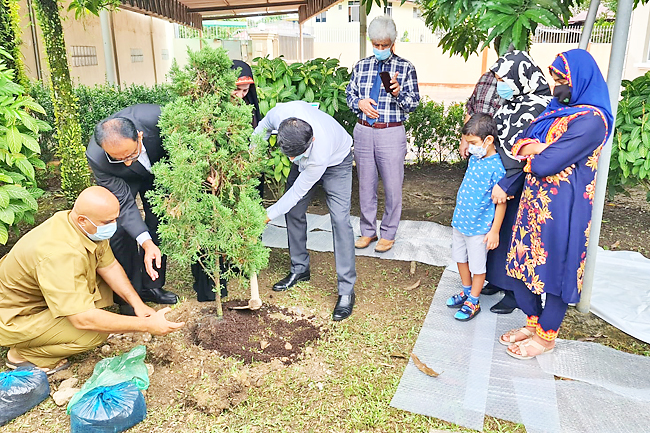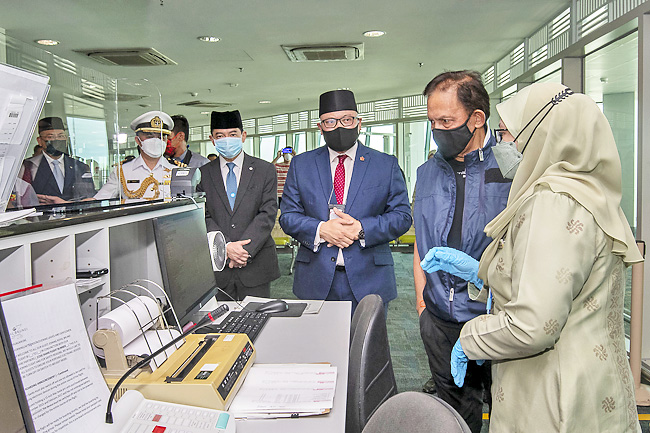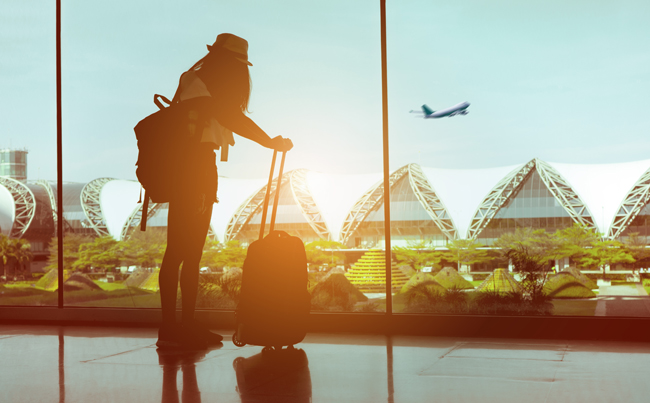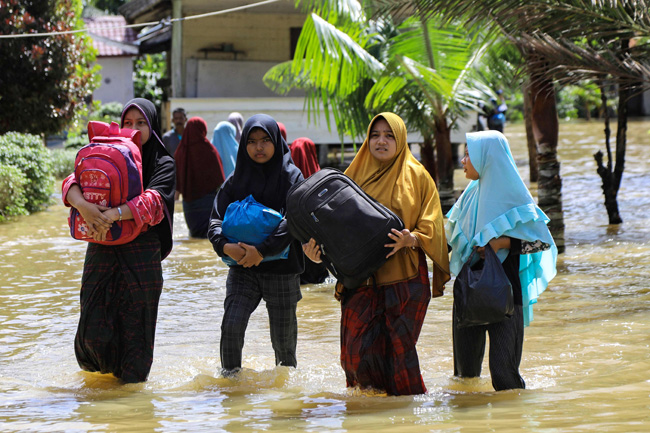G Daniela Galarza
THE WASHINGTON POST – “I guess it’s a compliment that imitators of Peru’s famous rotisserie chicken are everywhere,” Chef Ricardo Zarate wrote in his book, The Fire of Peru. “Problem is, unless you happen to have a rotisserie grill, it can be difficult to mimic the slowly rotating spit that gives the chicken that almost black, fantastically charred crust that seals in the natural juices so the chicken doesn’t dry out.”
In fact, I’d say that there’s no way to make true pollo a la brasa – unless you own a rotisserie contraption for your oven or grill – though there are ways to capture the same combinations of flavours.
If you’ve ever been to a restaurant that serves pollo a la brasa, you know the garlicky, salty and specifically savoury flavour of Peruvian-style rotisserie chicken. And you’ve likely seen the way chicken roasting on a spit against a steady flame can turn simultaneously succulent and crisp.
Earlier last year, I was thinking of my first taste of pollo a la brasa. It was at the appropriately named Pollo a la Brasa in Los Angeles, a famous stop where the smoke rises high into the sky every afternoon, and pick-up trucks regularly dump firewood near the shop’s back door. The loud thwack! of cleavers cutting cleanly, hitting wooden boards soaked in meat juices punctuates the usually jovial atmosphere. The menu is simple: Chicken, fries, salad, sauce.
Burnished as a well-baked loaf of bread, the deeply savoury crust on a piece of pollo a la brasa gives way to tender meat. Its drippings soak into the fries that go on every plate – and they even enhance the forgettable green salad next to them.
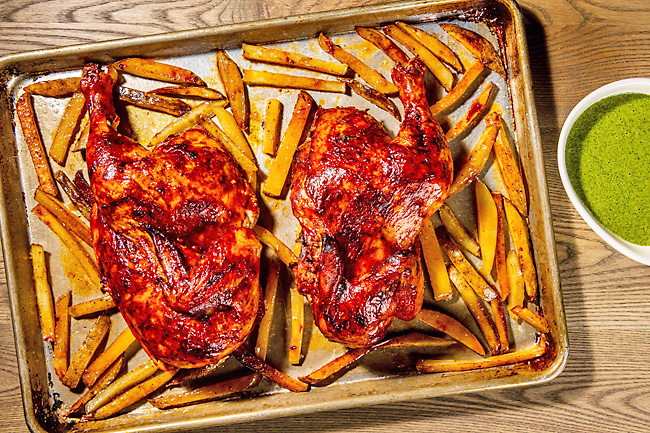
At every pollo a la brasa spot I’ve been to there is also a sauce, yellow or red or – my favourite – green with herbs and chilli and lime juice. Aji serves as a pungent salve for all the rich meat and potatoes, and a dressing that makes even the tired leaves of romaine and iceberg worth eating.
There’s a recipe for pollo a la brasa in Zarate’s book, which was written with Jenn Garbee.
But it’s a complex affair, involving a sous-vide-like process followed by a sear on a hot grill to give the chicken that signature lick of fire.
Here, I borrowed elements from Zarate’s marinade and seasoning rub – a blend of soy sauce, vinegar, hot sauce, cumin and Peruvian mint – and his method of splitting the chicken fully in half so that it cooks evenly. But then I turned this riff on the Peruvian classic into a sheet-pan meal, with potatoes that sizzle in the juices of the chicken, turning french fry-like in the process.
Dip each forkful in the punchy aji verde, a creamy sauce that takes minutes to make in a blender and pairs well with so many savoury dishes, whether they were roasted on a spit or not.
POLLO A LA BRASA WITH AJI VERDE
True pollo a la brasa, Peru’s famous chicken, requires a rotisserie – but there is a way to capture the flavours of the dish in a home oven. The key is the marinade, which involves aji panca or aji amarillo, two mild chilli commonly used in Peruvian cooking, and huacatay, a type of mint native to the Andes. Rub the chicken with the marinade and let it marinate overnight – or roast it right away, over potatoes cut into fries, to mimic the french fries commonly served with restaurant-style pollo a la brasa. For deeply burnished skin, baste the chicken with leftover marinade as it cooks.
Pollo a la brasa is often served with a green sauce called aji verde that gets its flavour from green chilli, huacatay and cilantro. Mayonnaise or a crumbly cheese like queso fresco is added for richness, though you can use Greek yogurt or feta cheese instead.
NOTE: To cut a chicken in half, using kitchen shears, cut through its backbone, then around through its breast bone until the two halves are separate. You may also ask a store butcher to do this.
Make Ahead: The chicken may be marinated overnight, if desired.
Storage Notes: Leftovers may be refrigerated in covered containers for up to four days.
INGREDIENTS
For the chicken
– Four tablespoons olive or vegetable oil, divided
– Four cloves garlic, minced or finely grated
– Two tablespoons soy sauce, tamari or Liquid Aminos
– Two tablespoons red vinegar
– One tablespoon aji panca paste or aji amarillo paste (may substitute with another chilli or hot sauce, such as sambal oelek, sriracha or Valentina)
– Two teaspoons jarred huacatay paste (may substitute with one tablespoon finely chopped fresh rosemary leaves)
– One teaspoon ground cumin
– One whole chicken, cut in half through the breastbone and backbone (see NOTE)
– Three large russet potatoes or sweet potatoes, cut into half-inch thick fries
– Quarter teaspoon fine sea salt or table salt
For the aji verde
– One-third cup mayonnaise, Greek yogurt, crumbled queso fresco or feta
– One ounce fresh cilantro leaves and tender stems, roughly chopped
– One tablespoon jarred huacatay paste (may substitute with half ounce fresh mint leaves and tender sprigs)
– Four cloves garlic
– One serrano or jalapeño, stemmed, deseeded and roughly chopped
– One tablespoon aji amarillo paste (optional)
– One teaspoon ground cumin
– Finely grated zest and juice of one lime
– Fine sea salt or table salt
DIRECTIONS
Make the chicken
In a large bowl or resealable bag, mix together two tablespoons of oil, the garlic, soy sauce, vinegar, aji panca or other chilli paste or sauce, huacatay paste or rosemary, and cumin. Add the halved chicken, turning to coat it on all sides and in all crevices with marinade.
Set aside while you prepare the potatoes – or cover the bowl or seal the bag and refrigerate overnight.
Position a rack in the middle of the oven and preheat to 375 degrees.
Pour the remaining two tablespoons of oil on a large, rimmed baking sheet. Add the potatoes and toss until well coated. Lightly season with salt. Shake the excess marinade off the chicken and place it, breast-side up, with the legs facing the rear of the oven, atop the potatoes; reserve the marinade. Roast for 35 minutes, then remove the baking sheet from the oven. Using tongs, turn the exposed potatoes so they brown evenly on all sides. Brush or spoon the remaining marinade evenly over the chicken.
Increase the oven temperature to 400 degrees, and roast chicken for an additional 10 to 15 minutes, or until well browned and an instant-read thermometer inserted into the thickest part of the thigh reads 165 degrees. Let the chicken rest for 10 minutes before serving.
Make the aji verde
To a blender, add the mayonnaise, yogurt or cheese, cilantro, huacatay paste or mint, garlic, serrano or jalapeño, aji amarillo paste, if using, cumin, lime zest and juice, and puree until smooth, stopping to scrape down the sides of the jar as needed. Taste, and season with salt, if desired.
Serve the warm chicken and potatoes, family-style, with the aji verde on the side.


